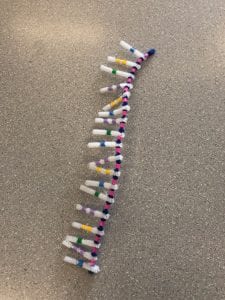 Purpose:
Purpose:
To determine the effects of temperature on the enzymatic process of lactase
Hypothesis:
Higher temperatures will yield a higher concentration of glucose. The reaction rate of lactase will be higher under warmer temperatures.
Materials:
- 8 Diastix strips
- 7 test tubs
- 7 stoppers
- Thermometer
- Milk
- Lactase Drops
- Boiling Water
- Ice Water
- Tap Water
- Graduated Cylinder
- 3 beakers
Procedure:
- Pour 15ml of milk into each test tube
- Test the initial concentration of glucose in the milk: Dip a Diastix strip into the milk. Remove and place on a paper towel and wait 30 seconds.
- After 30 seconds, observe the colour change of the Diastix strip, refer to the bottle’s chart and record the corresponding concentration of glucose.
- Prepare the different temperature water baths for each test tube. (prepare three water baths at a time)
- With the help of the thermometer, create water baths by mixing together tap water, boiling water, and ice water so they are the following temperatures: 5°C, 10°C. 20°C, 23°C (room temperature), 37°C, 40°C, 45°C
- Before placing the individual test tubes in their baths, measure the water and record the exact temperature.
- Add one drop of Lacteeze into a test tube, insert the stopper, and flip the test tube twice to mix the enzyme.
- Place the test tube of milk into the bath for 15 minutes
- After the 15 minutes are up, remove the stopper and find the concentration of glucose by using a Diastix strip
- Like before, dip the strip into the milk, remove and place on a paper towel. Wait 30 seconds then record the results of the Diastix strip.
- Repeat steps 7-10 for each test tube.
- Record the data into the data table.
- Graph the data.
Data:


Observations and Analysis
The beakers with the highest concentrations of 111mmol/L or more were in the beakers that were 6°C, 23°C, and 37°C. It’s worth noting that 37°C is body temperature. The lowest concentration was at 20°C. and the second lowest were at 10°C, 40°C, and 45°C. If we exclude the data point of the first beaker (5°C), the graph vaguely matches the reaction rate curve that was anticipated. The lower temperatures had lower reaction rates, then it reaches its peak reaction rate, and after that peak is reached, the reaction rate begins to decrease again.

Conclusion/Questions
How does temperature affect enzymatic processes?
Increasing the temperature (up until a certain point) will increase the efficiency of the enzymatic processes. This is because at higher temperatures the particles are moving faster, and more collisions are happening. These factors increase the likelihood of a successful reaction between the reactants, so the reaction rate will increase. If the temperature gets too hot, we begin to see the reaction rate actually drops. This is because the enzymes have started to denature, rendering them unable to perform their duties.
Why does the concentration of glucose begin to decrease at higher temperatures?
As mentioned before, the enzymes begin to denature if the temperature is too high (usually when it’s above 45°C). When an enzyme denatures, it is unable to properly perform its function which in this case is facilitating the reaction. As we increase the temperature past the denaturing point, more and more enzymes will stop functioning therefore decreasing the reaction rate which in turn decreases the production of glucose.
How did this lab help with your understanding of enzymes?
It helped a little bit. I was able to vaguely see the impact temperature made on the enzymes. It allowed me to apply my learning to an actual situation which in turn helps me remember the process. However, due to a variety of factors and/or possible errors.
What went well in this lab?
I think the thought put behind the design was quite good. We used a good variety of temperatures. For example, we had one at room temperature, body temperature and a couple above and below the denaturing point of the enzyme. This, in theory, would give us a diverse spread of results.
What are some problems/possible sources of error you encountered? How could the lab be improved?
The results of beaker one did not follow our theory. We believe that is likely due to an error. We found that the results weren’t as varied either. Our Diastix strips don’t provide a big enough range for our results. We could improve that by either using a testing strip that has a larger/more precise range or by reducing the amount of time we let the lactase react with the milk. Another potential source of error could be the temperature. We don’t know for certain if the initial temperature was maintained throughout the entire experiment. For example, the beaker at 6°C could’ve started to warm up during the 15 minutes. This increase in temperature will skew the results since the enzyme is now working under a higher temperature. We also didn’t give the milk time to properly adjust to the new temperature. We measured the temperature of the water, not the milk. When we initially put the milk in the water bath, it is at room temperature. After that the milk’s temperature increases or decreases during the 15 minutes. This means the temperature recorded may not reflect the actual temperature the enzyme was working under. These errors could be avoided by using containers with better insulation for the water bath. We could also base our temperature off the milk rather than the water. We could do that by placing the milk in the water bath but waiting until the milk itself adjusts to the right temperature.

















